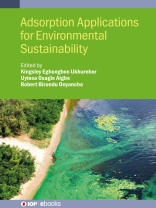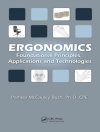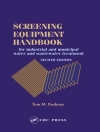This book highlights all the core aspects of the synthesis, characterization, and applications of biosorbents such as bionanocomposite, together with their recent advances in detail. Also, some new research and developments in biosorbents, such as bionanocomposite. It presents some of the recent principles of the synthesis, fabrication, and characterization of bionanocomposite and their applications, as well as some important tools and challenges associated with these techniques for engineers and scientists.
Hence, it is the first of its kind in the environmental and material science domain to explore a facile and all-inclusive approach to the applications of biosorbents such as bionanocomposite along with their future prospects and advantages.
**Key Features: **
-
Highlights the core aspects of the synthesis, characterization and applications of biosorbents such as bionanocomposite together with their recent advances in detail.
-
Provides some new research and developments in biosorbents such as bionanocomposites.
- Presents some of the recent principles of the synthesis, fabrication and characterization of bionanocomposites and their applications and also some important tools and challenges associated with these techniques for engineers and scientists.
- The first book in the environmental and material science domain to explore a facile and all-inclusive approach to the applications of biosorbents such as bionanocomposite along with their future prospects/advances.
Innehållsförteckning
Preface
Acknowledgements
Editor biographies
List of contributors
1 Introduction to the state of the art and relevant aspects of the applications of adsorption for environmental safety and sustainability
Kingsley Eghonghon Ukhurebor, Uyiosa Osagie Aigbe, Robert Birundu Onyancha, Kenneth Kennedy Adama, Osikemekha Anthony Anani, Ikenna Benedict Onyeachu, Joseph Onyeka Emegha, Benedict Okundaye, Bamikole Olaleye Akinsehinde, Olusoji Anthony Ayeleso and Grace Jokthan
1.1 Introduction
1.2 The development of AST
1.2.1 The principle, concept, and mechanism of AST
1.2.2 AST classification
1.3 Categories and sources of pollutants and emerging (newly identified) contaminants in water
1.3.1 Wastes from industry
1.3.2 Wastes from domestic activities
1.3.3 Wastes from animal farming
1.3.4 Wastes from agricultural activities
1.4 Various adsorbent types
1.4.1 Natural biological/organic adsorbents
1.4.2 Synthetic adsorbents
1.4.3 Natural inorganic/mineral adsorbents (or commercial/industrial adsorbents)
1.5 The application of the AST procedure
1.5.1 The application of AST in the removal of emerging (newly identified) pollutants
1.6 The state of the art and relevant advances in the applications of AST
1.7 Conclusions and future insights
References
2 The types, characteristics, and management options (reusability/recyclability/final disposal) of commonly used adsorbents in environmental sustainability
Kingsley Obodo and Uyiosa Osagie Aigbe
2.1 Introduction
2.2 Commonly used adsorbents
2.2.1 Carbon-based materials and activated carbon
2.2.2 Clay minerals
2.2.3 Silica gel
2.2.4 Zeolites
2.2.5 Polymeric materials
2.3 The properties of commonly used adsorbents
2.3.1 Pore size 2-13 2.3.2 Adsorption efficiency
2.3.3 Surface area
2.3.4 Selectivity
2.3.5 Regeneration ability
2.3.6 The modification of adsorbents
2.4 Management options
2.4.1 Reusability through desorption
2.4.2 Regeneration and cost
2.4.3 Final disposal
2.5 Conclusions and recommendations
References
3 Activated biosorbents for the removal of metals from aqueous solutions
Uyiosa Osagie Aigbe, Kingsley Eghonghon Ukhurebor, Robert Birundu Onyancha, Benedict Okundaye, Efosa Aigbe, Kingsley Obodo, Enaroseha O E Omamoke, Lunyanda Lunga Noto, Adelaja Otolorin Osibote and Harrison I Atagana
3.1 Introduction
3.2 Modification procedures
3.3 The sorption of heavy metals using activated biosorbents
3.4 Factors impacting the biosorption of heavy metal ions
3.4.1 The effect of p H on the biosorption of heavy metal ions
3.4.2 The effect of the biosorbent dosage
3.4.3 The effect of the nitial metal concentration
3.4.4 The effect of the contact time
3.4.5 Temperature and thermodynamic analysis
3.5 Kinetic studies
3.6 Equilibrium sorption isotherm
3.7 The mechanism of heavy metal biosorption
3.8 Conclusions and recommendations
References
4 Functionalized biosorbents for the sequestration of dye from aqueous solutions
Uyiosa Osagie Aigbe, Kingsley Eghonghon Ukhurebor, Robert Birundu Onyancha, Benedict Okundaye, Efosa Aigbe, Kingsley Obodo, Lunyanda Lunga Noto, Adelaja Otolorin Osibote and Harrison I Atagana
4.1 Introduction
4.2 The functionalization of biosorbents
4.3 The biosorption of dyes using functionalized biosorbents
4.4 Factors impacting the biosorption of dyes
4.4.1 The influence of p H on dye biosorption
4.4.2 The influence of the initial dye concentration on the biosorption of dyes
4.4.3 The influence of the biosorbent dosage on the biosorption of dyes
4.4.4 The influence of the contact time on the biosorption of dyes
4.5 Biosorption isotherm models and kinetic models
4.5.1 Isotherm models
4.5.2 Biosorption kinetic models
4.6 Thermodynamic studies
4.7 The mechanisms of thebiosorption process
4.8 Conclusions
References
5 The sequestration of heavy metals from soil using functionalized biosorbents
Uche Eunice Ekpunobi, Daniel Elaigwu Enenche, Chales Ifeanyi Aghanwa, Abimbola Bankole Akinyele, Patrick Ugochukwu Umennadi, Uzochukwu Abraham Onuigbo and Austin Ozukwe
5.1 Introduction
5.2 Natural sources of heavy metals
5.2.1 Anthropogenic sources of heavy metal contamination
5.2.2 The bioavailability (speciation) of heavy metals
5.3 Factors affecting the speciation of heavy metals
5.4 The toxicity of heavy metals
5.5 Soil remediation
5.5.1 Types of remediation
5.6 Bioremediation
5.6.1 Factors affecting the biosorption process
5.6.2 The preparation of biosorbents
5.6.3 The mechanism of biosorbent action in the sequestration of heavy metals
5.6.4 Metabolism-dependent biosorption
5.6.5 Non-metabolism-dependent biosorption
5.6.6 Factors affecting the different types of biosorbents in the sequestration of heavy metals
5.6.7 Advantages (the strengths of various biosorbents)
5.6.8 Disadvantages (limitations of biosorbents for heavy metal sequestration)
5.7 Conclusions, recommendations, and the way forward
References and further reading
6 The photocatalytic degradation of dyes and metal ions using functionalized biosorbents
Benedict Okundaye, Kingsley Eghonghon Ukhurebor, Uyiosa Osagie Aigbe, Efosa Aigbe, Vincent Aizebeoje Balogun and Ahmed El Nemr
6.1 Introduction
6.2 The sources and effects of dyes and metal ions on the environment
6.3 Techniques for removing dyes and metal ions from the environment
6.4 Photocatalytic degradation of dyes and metal ions using functionalized biosorbents
6.5 Conclusions
References
7 The effective sensing and sequestration of metal ions and dyes using functionalized biosorbents
Robert Birundu Onyancha, Uyiosa Osagie Aigbe, Kingsley Eghonghon Ukhurebor, Bill Clintone Oyomo, Stephen Chege and Michael O Atambo
7.1 Introduction
7.2 The detection or sensing of heavy metals and dyes
7.2.1 Spectroscopic sensing techniques
7.2.2 Electrochemical methods of sensing
7.2.3 Optical sensing methods
7.3 Sequestration methods
7.3.1 Chemical precipitation (CP)
7.3.2 Adsorption techniques
7.3.3 Ion exchange technique
7.3.4 Membrane filtration methods
7.3.5 The electrochemical method
7.4 Conclusions
References
8 The application of microorganism-derived biosorbents in the removal of heavy metals and dyes
Joan Nyika and Megersa Olumana Dinka
8.1 Introduction
8.2 Mechanisms of biosorption
8.3 Types of biosorbents
8.3.1 Microbial biosorption
8.3.2 The removal of heavy metals via microorganism-based biosorption
8.3.3 The removal of dyes through microorganism-based biosorption
8.4 Prospects for the application of biosorbents for heavy metal and dye remediation
8.5 Conclusions
References
9 The use of biosorbents derived from invasive plants for environmental remediation
W O Egboduku, T Egboduku, J O Emegha and O Imarhiagbe
9.1 Introduction
9.2 Categories of biosorbents
9.3 Biosorbents derived from invasive plants
9.4 The production of biosorbents/biochars from invasive plants
9.5 Preparing biosorbents from invasive plants
9.6 The mechanism of biosorption
9.7 Conclusions
References
10 Microorganism-derived biosorbents in the sequestration of contaminants from the soil
Timothy Imanobe Oliomogbe, Joseph Onyeka Emegha and Kingsley Eghonghon Ukhurebor
10.1 Introduction
10.2 Heavy metals and the environment
10.3 An overview of biosorption
10.4 Modification of biosorbents
10.5 The biosorption process
10.6 Biosorption mechanisms
10.6.1 Complexation
10.6.2 Chelation
10.6.3 Coordination
10.6.4 Ion exchange
10.6.5 Precipitation
10.6.6 Reduction
10.7 The pros and cons of biosorption
10.7.1 Pros
10.7.2 Cons
10.8 Various factors that impact the biosorption processes
10.8.1 The effect of p H
10.8.2 The effect of temperature
10.8.3 The effect of time
10.8.4 The effect of the initial metal concentration
10.8.5 The effect of agitation speed
10.9 Biosorbents for the removal of heavy metals from soil
10.9.1 Algae as biosorbents
10.9.2 Fungi as biosorbents
10.9.3 Bacteria as biosorbents
10.10 Conclusions
References
11 Modeling the adsorption process of the biosorbent-based decontamination of aqueous solutions using kinetic and isotherm models
Philomina Nkeonye Okanigbuan, Uyiosa Osagie Aigbe and Kingsley Eghonghon Ukhurebor
11.1 Introduction
11.2 The use of isotherm models and kinetic models for biosorption processes
11.3 Isotherm models
11.4 Kinetic models
11.5 Conclusions
References and further reading
12 Green biosorbents for the degradation of petroleum contaminants
Joseph Onyeka Emegha, Timothy Imanobe Oliomogbe, Joel Okpoghono, Adeoye Victor Babalola, Chioma Adaku Ejelonu, Dennis Eyetan Elete and Kingsley Eghonghon Ukhurebor
12.1 Introduction
12.2 An overview of green biosorbents
12.3 The characteristics of green biosorbents
12.4 Algae as biosorbents
12.4.1 Algae-based biosorbents for petroleum pollutant removal
12.4.2 Algae-based biosorbents for crude oil removal
12.4.3 The removal of polycyclic aromatic hydrocarbons using algae‑derived biosorbents
12.5 Bacteria and fungi as biosorbents
12.5.1 Bacteria and fungi-based biosorbents for petroleum pollutant removal
12.5.2 Bacteria and fungi-based biosorbents for crude oil removal
12.5.3 The removal of polycyclic aromatic hydrocarbons using bacterial and fungal biosorbents
12.6 Major factors which can impact the process of biosorption
12.6.1 Temperature
12.6.2 The moisture content of the soil
12.6.3 Acidity or alkalinity
12.6.4 The chemistry of hydrocarbons
12.6.5 Oxygen availability
12.6.6 The degree of salinity
12.6.7 The ionic strength
12.6.8 Bioavailability
12.7 The benefits of the biosorption process
12.8 Conclusions
References
13 The use of the response surface methodology for the adsorption of heavy metals and dyes by biosorbents
Juliana O Iji, Ayodeji O Oyedeji, Salami A Kazeem, Maryann I Uzochukwu, Cynthia U Odili, Abdullahi S Argungu, Fatima B Badiru, Stefan Csaki and David O Obada
13.1 Introduction
13.2 Tannery wastewater characteristics
13.2.1 Total nitrogen
13.2.2 Total phosphorus
13.2.3 Chloride ions
13.2.4 Chromium salt
13.2.5 Sulfur-containing compounds
13.2.6 Heavy metals
13.3 RSM techniques for wastewater treatment
13.3.1 Procedures for RSM
13.3.2 Applications of RSM in wastewater treatment
13.4 The application of porous ceramics in tannery WW remediation
13.4.1 Processing techniques for porous ceramics
13.4.2 Materials used to fabricate porous ceramics
13.5 Industrial applications of membranes for water treatment
13.6 Issues that need to be resolved and possible solutions
13.7 Conclusions
References and further reading
14 Cost and environmental evaluations and comparisons of commonly used sorbents
Kingsley Obodo and Uyiosa Osagie Aigbe
14.1 Introduction
14.2 General parameters affecting the cost of sorbents
14.2.1 Sorbent material
14.2.2 Sorbent quantity
14.2.3 Sorbent regeneration
14.2.4 Operating conditions
14.2.5 Sorption efficiency
14.2.6 Contaminant concentration
14.2.7 Sorption capacity
14.2.8 Sorption kinetics
14.2.9 Regeneration efficiency
14.2.10 The scale of operation
14.2.11 Other parameters
14.3 The costs and environmental evaluations of commonly used sorbents
14.3.1 Overview
14.3.2 Recent interest in common sorbents for environmental remediation
14.4 Conclusions
References
15 The challenges of, and perspectives on adsorption applications for environmental sustainability
Kingsley Eghonghon Ukhurebor, Uyiosa Osagie Aigbe, Robert Birundu Onyancha, Kenneth Kennedy Adama, Osikemekha Anthony Anani, Joseph Onyeka Emegha, Benedict Okundaye, Rout George Kerry, Atala Bihari Jena, Francis Jesmar P Montalbo, Olusoji Anthony Ayeleso, Grace Jokthan and Aizebeoje Balogun Vincent
List of unusual acronyms used
15.1 Introduction
15.2 The effects of wastewater pollution on the environment
15.3 Treatment methods or technologies for wastewater
15.4 Challenges of adsorption applications for environmental safety and sustainability
15.5 Perspectives on adsorption applications for environmental safety and sustainability
15.6 Conclusions
References
Om författaren
Kingsley Eghonghon Ukhurebor is a lecturer/researcher and the present acting head of the Department of Physics at Edo State University, Uzairue, Nigeria, and a research fellow at the West African Science Service Center on Climate Change and Adapted Land Use (WASCAL), Competence Center, Ouagadougou, Burkina Faso, a Climate Institute sponsored by the Federal Ministry of Education and Research, Germany. He had a Ph.D. in Physics Electronics from the University of Benin, Benin City, Nigeria. He is a member of several learned academic organizations, such as the Nigerian Young Academy (NYA), etc. His research interests are in applied physics, climate physics, environmental physics, telecommunication physics, and material science (nanotechnology). He serves as editor and reviewer for several reputable journals and publishers, such as Springer Nature, Elsevier, Royal Society of Chemistry (RSC), Institute of Physics (IOP), Taylor & Francis, John Wiley & Sons, IEEE, Frontiers, Hindawi, etc. He has authored and co-authored several publications with these reputable journals and publishers. He is presently ranked among the top 500 authors in Nigeria by Scopus scholarly output.
Uyiosa Osagie Aigbe is a research fellow with the Department of Mathematics and Physics, Faculty of Applied Science, Cape Peninsula University of Technology, Cape Town, South Africa. He obtained his Ph.D. degree in Physics from the prestigious University of South Africa, Pretoria, South Africa. He is currently a member of several learned academic organizations. His research interests are in applied physics, nanotechnology, fluid dynamics, water purification processes, image processing, environmental physics, and material science. He has also served as a reviewer for numerous highly regarded journals. He has authored and co-authored several research publications.
Robert Birundu Onyancha is a lecturer and researcher working full-time at the department of Technical and Applied Physics, School of Physics and Earth Science at the Technical University of Kenya. He holds a Ph.D. in Physics from the University of South Africa. His research interests are in material science, waste water treatment technologies, superconductivity and magnetism. He is a registered member of various research bodies and has authored and co-authored research papers and book chapters which have been published in reputable and accredited in journals and publishers. Furthermore, he serves as an editor and reviewer of highly accredited and trustworthy journals.












